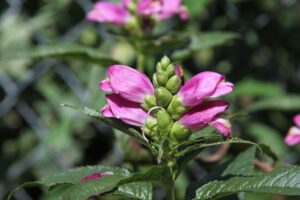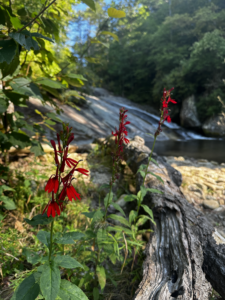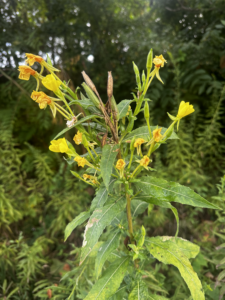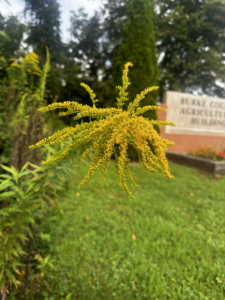Late Season Wildflowers
go.ncsu.edu/readext?956668
en Español / em Português
El inglés es el idioma de control de esta página. En la medida en que haya algún conflicto entre la traducción al inglés y la traducción, el inglés prevalece.
Al hacer clic en el enlace de traducción se activa un servicio de traducción gratuito para convertir la página al español. Al igual que con cualquier traducción por Internet, la conversión no es sensible al contexto y puede que no traduzca el texto en su significado original. NC State Extension no garantiza la exactitud del texto traducido. Por favor, tenga en cuenta que algunas aplicaciones y/o servicios pueden no funcionar como se espera cuando se traducen.
Português
Inglês é o idioma de controle desta página. Na medida que haja algum conflito entre o texto original em Inglês e a tradução, o Inglês prevalece.
Ao clicar no link de tradução, um serviço gratuito de tradução será ativado para converter a página para o Português. Como em qualquer tradução pela internet, a conversão não é sensivel ao contexto e pode não ocorrer a tradução para o significado orginal. O serviço de Extensão da Carolina do Norte (NC State Extension) não garante a exatidão do texto traduzido. Por favor, observe que algumas funções ou serviços podem não funcionar como esperado após a tradução.
English
English is the controlling language of this page. To the extent there is any conflict between the English text and the translation, English controls.
Clicking on the translation link activates a free translation service to convert the page to Spanish. As with any Internet translation, the conversion is not context-sensitive and may not translate the text to its original meaning. NC State Extension does not guarantee the accuracy of the translated text. Please note that some applications and/or services may not function as expected when translated.
Collapse ▲It may seem like summer is coming to a close and that fall color is on its way. However, there are many native wildflowers that are just starting to show their colors. If you spend any time outdoors late this summer, keep an eye out for these late season perennial wildflowers.
Beggar’s Lice – Desmodium spp. – Perennial.

Beggars Lice
Beggarlice, classified under the genus Desmodium, typically grows as herbaceous perennials, attaining heights of 2 to 4 feet. Their leaves are arranged alternately and consist of three leaflets, characterized by hooked hairs on the underside. These plants produce flowers in varying shades, ranging from white to violet, and they bear triangular seeds that cling like ticks, giving rise to their common name.
One notable feature of Beggars lice is their low flammability, making them less susceptible to wildfires. Their seasonal appeal lies in late summer blooms, followed by the development of nuts, fruits, and seeds in the fall.
They are a preferred food source for various wildlife, including bobwhite, turkey, grouse, and deer. Moreover, these plants serve as larval host plants for several butterfly species. Their seeds, particularly in winter, become essential nourishment for songbirds, quail, and small mammals.
Beggar’s Lice can be found in rocky soils near upland areas, such as the Linville Gorge.
Pink Turtleheads – Chelone obliqua Perennial

Pink Turtlehead
Jim, the Photographer CC BY 2.0
Turtlehead is a clumping native perennial belonging to the plantain family. It thrives in moist forested regions of the southeastern United States, with a relatively rare presence in North Carolina. This distinctive plant showcases pinkish-purple flowers that appear on terminal spikes, resembling snapdragons and earning it the common name “Turtlehead” due to their resemblance to a turtle’s head. The blooming period for these striking flowers extends from July to October.
It prefers a habitat with full sun to dappled sun exposure and thrives in rich, humusy soils enriched with composted leaf mulch. Notably, Turtlehead serves as a magnet for bees and hummingbirds, making it a valuable addition to wildlife-friendly gardens.
While Turtlehead is available in the commercial market, caution should be exercised when making a purchase. It is often sold as a hybrid, so it’s essential to ensure that you are obtaining the genuine species to enjoy the unique qualities of this captivating native perennial.
Cardinal Flowers – Lobelia cardinalis – Perennial

Cardinal Flowers
The Cardinal flower is a captivating herbaceous perennial belonging to the Campanulaceae family. Reaching heights of 4 to 5 feet, the blooms are a bright red shade.
This resilient plant thrives in rich, moist to wet soil and flourishes in full sun to partial shade. It’s crucial to keep the soil consistently moist, with some tolerance for brief flooding.
The Cardinal flower boasts shiny, toothed leaves that are arranged alternately. Its rhizomes overwinter with small rosettes of leaves. The brilliant red blooms make their appearance from late summer through mid-fall, with flowers opening from the bottom to the top of the terminal flower spike. Propagation can be done through either seeds or by separating rosettes from the parent plant in spring.
This plant thrives in various settings, including woodland/shade areas, wet meadows, and along creeks. It adds late summer color and height, provided the soil remains uniformly moist. Its allure extends to pollinators, attracting hummingbirds and butterflies.
Common Elephant’s Foot – Elephantopus tomentosus – Perennial
Elephant’s foot, a wildflower belonging to the Asteraceae (daisy family), is native to the southeastern United States, spanning from Texas to its eastern regions. This resilient plant thrives in a variety of habitats, including fairly dry woodlands, woodland borders, and disturbed areas like roadsides, clear-cut areas, and burned locations.
Ideal conditions for Elephant’s foot include average, well-drained soil in either full sun or partial shade. It exhibits a unique growth pattern, characterized by a short rhizome, quickly reaching a height of 2 feet. Its eye-catching pink or purple flowers add a vibrant touch to its appearance. The leaves cluster at the plant’s base, varying in size and overlapping around the stem, lying flat close to the ground.
Elephant’s foot produces striking inflorescences in the form of heads arranged in panicles or corymbs. The flowers consist of 4 to 5 lobed disk flowers, typically pink or purple, occasionally white, encircled by three conspicuous bracts. This wildflower delights with its blooms from August through November, gracing its surroundings with color and beauty.
In summary, Elephant’s foot is a native wildflower with adaptability to a range of environments, from woodlands to disturbed areas.
Yellow Ironweed – Verbesina alternifolia – Perennial

Yellow Ironweed
Yellow Ironweed, a deciduous wildflower native to North America, thrives primarily in the Piedmont and mountainous regions of North Carolina. Its native habitat encompasses fertile areas of moist wooded slopes, open woodlands, riverbanks, shaded lowlands, roadsides, and fields. This robust plant can reach heights of up to 8 feet and thrives in both full sun and partial shade, making it adaptable to various environments. However, it’s worth noting that Yellow Ironweed can be aggressive in its spreading tendencies.
This wildflower is a valuable resource for bees, attracting pollinators with its vibrant and showy daisy-like flowers. The blooms, which occur in dome-shaped panicles, are composed of 3-10 yellow petals that reflex backward, surrounding a pincushion-like greenish-yellow center. Flowering typically takes place from July to October, providing essential forage for pollinators during the fall and summer seasons.
Yellow Ironweed’s ecological importance extends beyond its role as a bee attractor. It serves as a larval host for various species, including the gold moth, Summer Azure butterfly, and the silvery checkerspot. Additionally, it exhibits resistance to challenges from deer and rabbits, making it a resilient and wildlife-friendly addition to naturalized areas, native plantings, woodland edges, and aquatic environments along ponds and streams. This native wildflower not only enhances landscapes with its golden blooms but also supports local biodiversity and pollinator populations.
Evening Primrose – Oenothera biennis – Biennial/Perennial

Evening Primrose
The Evening Primrose, an upright biennial plant within the Onagraceae family, thrives in a variety of habitats, including fields, prairies, glades, thickets, waste ground, disturbed areas, roadsides, and railroad right-of-ways. Its naturalizing tendencies make it an ideal choice for border plantings, wildflower gardens, cottage gardens, and herb gardens. Notably, this species is highly drought-tolerant, making it a resilient addition to landscapes.
The name “Evening Primrose” is derived from its fascinating floral behavior. The flowers open at dusk and close in the morning when exposed to sunlight, lending the plant its common name. These blooms emit a mild lemon fragrance that attracts night-flying moths for pollination, while bees visit them in the early morning hours before closure.
Evening Primrose produces slender capsules that release numerous seeds when ripe, promoting its naturalization in the landscape. Although the plants die after seed production, they readily self-propagate.
In terms of wildlife value, the Evening Primrose plays a crucial role. Night-flying moths and bees are drawn to its blossoms for pollination, while the seeds become a food source for birds.
Primarily found in eastern and central North America, this versatile plant attracts butterflies, pollinators, songbirds, and specialized bees, contributing to both the beauty and ecological value of various landscapes.
Goldenrod – Solidago spp. – Perennial

Goldenrod
The genus name, Solidago, derived from the Latin “Solidus,” meaning “to make whole,” alludes to the plant’s historical use in traditional medicine by Native Americans for its healing properties.
Goldenrod is remarkably adaptable, thriving in full sun and average to dry or medium, well-drained soil. It can withstand poor, dry soils, clay, and drought, making it a resilient and forgiving garden plant. Its naturalizing tendencies may require occasional division every few years to manage its spread, achieved either through wind-driven seeds or by dividing underground rhizomes.
These plants are not only visually appealing but also attract a variety of wildlife. Abundant nectar production lures bees, wasps, and butterflies, while the seeds are a favorite of birds. Goldenrod is also known for its resistance to deer.
One common misconception is that Goldenrod causes allergies; however, it’s ragweed that typically triggers allergies with wind-borne pollen. Goldenrod hybrids and cultivars have gained popularity in Europe and are increasingly appreciated in North America, especially when paired with blue wood asters and hardy ageratum for a delightful color and form combination.
Different Goldenrod species suit various environments and soil conditions, so it’s advisable to consider their native habitat when selecting plants for landscaping. Some species with spreading rhizomes may not be suitable for garden settings.
In summary, Goldenrod is a vibrant, resilient, and ecologically valuable perennial. It supports various wildlife, showcases bright blooms, and can thrive in diverse conditions, making it a valuable addition to gardens and natural landscapes alike.
Joe Pye Weed – Eutrochium purpureum – Perennial
Joe-Pye Weed, an erect, clump-forming native perennial in the Aster family, is celebrated for its beautiful and fragrant flowers. Its pinkish-to-purple, tubular-shaped blooms are arranged in a dome, reaching 12 to 18 inches across and exuding a delightful vanilla scent. These charming flowers grace the landscape from summer through early fall, attracting butterflies, bees, and contributing to honey production.
This plant boasts lance-shaped, green leaves with serrated margins, arranged in whorls of 3 to 4 along its sturdy, green stems. With a height of 5 to 7 feet and a width of 2 to 4 feet, Joe-Pye Weed makes a substantial presence in gardens.
Native to Southeast Canada and the Central and Eastern United States, this species thrives in various environments, including roadsides, moist prairies, thickets, woodland borders, shaded riverbanks, and wooded slopes.
Joe-Pye Weed thrives in full sun to partial shade and well-drained to occasionally wet soils, although it dislikes dry conditions.
Tall Ironweed – Vernonia gigantea – Perennial
Giant Ironweed, a native herbaceous perennial wildflower within the Asteraceae (daisy) family, exhibits an impressive presence in the landscape. Its tall and narrow habit emerges in spring, typically reaching heights of 3 to 5 feet but occasionally towering to 12 feet. Lavender, magenta, or deep purple flowers adorn this wildflower in late summer to early fall, while its tiny seeds, equipped with tufts of bristles, are easily dispersed by the wind.
Giant Ironweed prefers full sun to partial shade and well-drained, moist to wet soils. It exhibits tolerance to a wide range of soil pH levels, thriving in loam, clay-loam, or sandy-loam soils.
Characterized by tall, erect, stiff, and rounded stems, Giant Ironweed bears flat-headed panicles of flower heads atop its central stem, measuring up to 16 inches in diameter. Each flower head boasts 10-30 tubular florets in shades of lavender, magenta, or deep purple. Dark green leaves with serrated margins grace the plant’s upper surface, while the undersides are slightly hairy and paler green.
Giant Ironweed attracts pollinators like butterflies and bees, while its bitter-tasting foliage deters most small mammals and livestock from grazing on it.
This list is by no means exhaustive. Our region is a hub of biodiversity, so spend some time outdoors getting to know the native flora and fauna. Exploring the diversity of North Carolina’s flora and fauna in late summer can be a rewarding outdoor activity, allowing you to appreciate the region’s rich natural heritage.
For additional information on specific plant species, visit the North Carolina Extension Gardener Plant Toolbox




